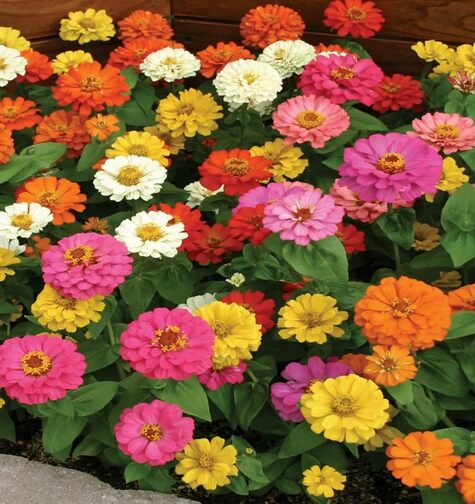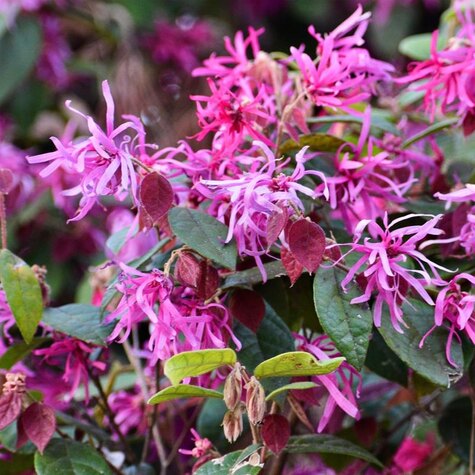
Thumbelina Mix Zinnias from Burpee.com
~Tell the truth.
~Sing with passion.
~Work with laughter.
~Love with heart.
‘Cause that’s all that matters in the end.
~Kris Kristofferson~
Despite the lingering hot weather and lack of rain, we can look to future days of cooler temperature coming soon. There is time, meanwhile, to prepare garden beds for planting, empty and clean old flower pots for growing fall flowers, clean and sharpen tools, and do a safety check along all paths, making ready for the great fall that’s coming!
- Zinnias, along with marigolds and chrysanthemums, are the flowers we associate with Fall. The Thumbelina variety of zinnias are well named, as they grow to only 12-inches, making them perfect for borders and containers. These colorful double and semi-double 2-inch flowers are showy and edible, making them a striking garnish for salads, desserts, and serving trays. Many of the more traditional, taller varieties, such as Zinnia elegans, grow up to 4-feet, with flowers up to 6-inches in width; this variety needs stakes for support. Zinnias grow in colors from white and pale yellow, to gold, orange, pink, purple, red, and other hues. Thumbelina and many other varieties from Burpee are disease resistant, adaptable to many soil types, and will bloom to first frost with proper care.

Wave® Petunias from Ball Horticultural Company (BallHort.com)
- Petunias grow exceptionally well during the fall in our area, and add a blast of color whether planted in a garden, container, or in a hanging basket. Information on Neil Sperry’s web site says that “petunias grow best when temperatures stay below 85 degrees. In fact, they can do very well even during the last weeks of winter if you’ll protect them from extreme cold.” All petunias need full sun (6 hours). Feed them every two weeks, or with a slow-release granular fertilizer.
- When looking for petunias, consider choosing plants from the Wave® Family of petunias. The varieties include: 1) Wave®, which creates a ground-hugging carpet of color; 2) Shock Wave®, which produces a mounded, spreading plant of petite flowers, making it a perfect choice for small space gardens; 3) Easy Wave®, has fast-growing plants that bloom freely without cutting back, and tolerates cooler conditions very well; 4) Double Wave® has frilly, double flowers that makes an outstanding performance in mixed containers, baskets, or gardens; and 5) Cool Wave®, which has bi-color faces, and a spreading, trailing growth pattern.
- Later this month and into November is the time to seed spring-blooming wildflowers like bluebonnets, phlox, Mexican hat, Indian paintbrush, Indian blanket (gaillardia). It’s not too late to look through a seed catalogue or an online site, and order your favorites.

Japanese Maple from EpicGardening.com
- October is the perfect month for planting shrubs and trees, as it will give them time to establish a good root system before winter cold sets in. Japanese boxwood, and Yaupon and Burford hollies with their red berries in winter, will bring some later color and winter food for birds to the landscape. The large native shrub, Texas Sage, produces soft pink/purple flowers after heavier rainfalls, and is almost maintenance-free. For a greater impact of color, Japanese Maple, with its spreading branches, will bring a deep purple color to the landscape. More on maples rom EpicGardening and Monrovia.

Chinese Fringe Flower ‘Rubrum’ from North Carolina Extension AgriLIfe (cals.ncsu.edu)
- Chinese Fringe Flower (Loropetalum chinense) is a compact evergreen that can be see in our area as a popular hedge plant for borders. It blooms in the spring with pink-to-red flowers, and provides colorful leaves throughout the year. There are several pink flowering varieties, including ‘Blush,’ ‘Burgundy,’ ‘Carolina Midnight, ‘Ever Red,’ and ‘Pizazz’. The white flowering forms include ‘Carolina Moonlight’ and ‘Snow Muffin.’ Plant in sun-to-partial-shade, starting off with a good potting mix; it will adapt to various growing conditions. Read more.
- Toward the end of the month, prepare your houseplants for overwintering: trim and divide them as needed, place in a clean pot with fresh soil, add time-release granular fertilizer, place them in a sink, large container, or outside and water well. Be sure to look under leaves and in the soil for insects and/or their eggs. Re-pot the extra plants as gifts. This also applies to any outside potted plants that may be harmed by winter weather.

Fall Vegetables from DavidsGardenSeeds.com
- Vegetables grow better with friends! ‘Companion Planting’ brings together vegetables and flowers that help the vegetables grow better and become more flavorful, to help protect them from harmful insects, and to attract those insects that are beneficial. David and Juanita Schulze in Poteet offer excellent advice and combinations of plants for our area.
- It’s time to plant broccoli, greens, squash, peas, beans, and root vegetables, like beets, green onions, and turnips. Add compost to beds and mix in well, to prepare for seeds or transplants.
- Travis County AgriLife [Austin is in Travis, Hays, and Williamson counties] recommends the use of transplants instead of seeds for certain vegetables. “Central Texas has two very short growing seasons. Brussels sprouts don’t have enough days-to-harvest in their ideal growing temperatures unless started as transplants,” their website says. This site has a long list of recommended vegetables varieties and their days-to-harvest, along with links to specific vegetables for more details. Their site on Vegetable Varieties for Central Texas is a valuable and useful resource.
by CMG Adrienne M
Sources: These and other sites: plants.ces.ncsu.edu; DavidsGardenSeeds.com; AlvarezNursery.com; NeilSperry.com; Travis County AgriLife. North Carolina Extension Gardener Plant Toolbox.